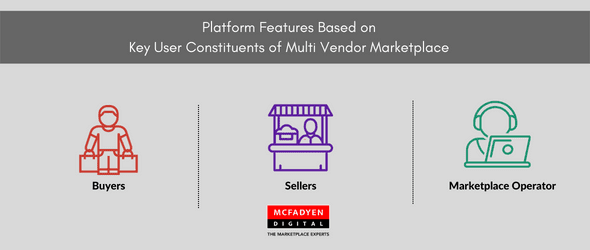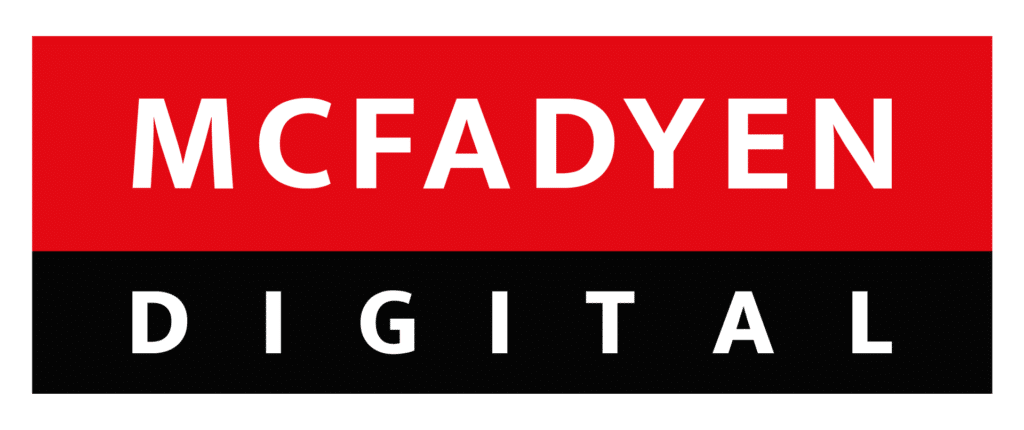
If you have been looking for a list of must-have features on your online marketplace, your search ends here.
Introduction
Online marketplaces have been growing phenomenally over the past few years. Pandemic-related have forever changed the way both consumers and businesses shop. As a result, there has been a significant shift from physical sales to online. Be STF forecasts that B2B online sales via marketplaces will reach USD 4.0 trillion mark in 2025. In other words, marketplaces will account for 14% of total B2B eCommerce sales by 2025. This is a perfect time to be in the business of online marketplace. So, if you are planning to start a marketplace or already have an established marketplace, this list of must-have features should help you immensely. At McFadyen Digital, we have helped numerous enterprises stand up their online marketplace and steered them towards profitability. We have completed over 250 large-scale eCommerce, marketplace, marketing, and user experience projects over 30 years. Given this, we can confidently say we have some idea about what we are talking about here. We also publish a biannual marketplace platform evaluation report called “The Marketplace Suite Spot℠” report. It evaluates the leading marketplace development technologies businesses can use to create, launch, and grow an eCommerce marketplace.
All successful and profitable online marketplaces have one thing in common – a great set of features. While each marketplace has a unique set of feature requirements, in this blog, we will present the features that most use and cover features that are only starting to trickle into the marketplace landscape.

So, what is a good starting point to analyze the features a marketplace needs? We are going to keep this simple. A marketplace has three primary constituents, the buyer, the seller, and the marketplace operator/ platform (Ref Fig1). Our features list will follow these three constituents. Let’s get right into it.
Marketplace Platform Features for Operator
Marketplace Performance Dashboards – Marketplace performance management is knowing which metrics are crucial to success and which levers to pull to grow those metrics. Many of the traditional eCommerce metrics matter to a marketplace operator, but the seller community adds an entirely different dimension requiring quantification and continual adjustment. Delivering a profitable marketplace model requires diligence, careful measurement, and timely course correction. In more significant marketplaces, over 50 KPIs are typically measured to indicate the business’s health. It is hard to overstate the dynamic nature of a marketplace—new buyer communities, new product offerings, and new suppliers all combine to make efficient measurement a challenge. The answer is a holistic analytics approach to the complex analytics needs of marketplace environments and complex multichannel eCommerce. McFadyen Digital has created the Marketplace Performance Management (MPM) Dashboard, a purpose-built solution that allows businesses to respond quickly to some of the most compelling questions in complex eCommerce. With over 100 commerce-focused KPIs, you can look at homogenized data that will help you gain a deeper understanding of what has happened and the implications for the future.
Embedded Financials – This is turning out to be a very effective retention strategy for online marketplace operators and is already being described as the next step in the evolution of online marketplaces. Embedded finance allows online marketplace operators to provide customers with upgraded engagement and loyalty tools. For sellers in the platform, it allows them to access business banking services tied directly to their sales on the marketplace. This enables marketplace operators to drive new revenue streams by making money on all transaction types taking place on the platform. By embedding payment processing, it gets a piece of every transaction. This transaction amount, formerly sent to the banks, feeds back into the marketplace’s bottom line.
Monetization Tools for Revenue Generation – With an ever-changing technology landscape and the advent of Web 3.0, the number of ways to monetize interaction is increasing. These include vendor subscriptions, signup, insertion and selling fees, featured and sponsored products, stores, and more. The marketplace platform of choice should have features that allow it to monetize these activities. Here’s a very insightful article from MultiMerch about “10 Marketplace Business Models To Generate Revenue“.
Marketing Features– One cannot grow a marketplace if the platform itself is not built around the concept of growth and marketing. Every marketplace needs heavy promotion until they are established and gain some traction. Some of the automated features best-of-the-breed platforms provide are; search engine optimization, social media integrations, user-friendly interfaces, and referral/ loyalty programs.
Headless Commerce – With ever-shifting consumer behavior and technologies, it has become a challenge for brands/ retailers and marketplace operators to provide a seamless user experience. The headless architecture uses APIs to exchange real-time information between the front-end, back-end, and consumer at the forefront. This enables easy integration and management of multiple channels. Headless commerce allows for instantaneous changes and optimization possibilities. It’s easier to provide a rich user experience when the platform can control all the elements users interact with within the marketplace.
Marketplace Platform Features for Sellers
Simple Signup & Onboarding – One of the ways to scale up the process of onboarding sellers is to have a simple signup process and onboarding. The more friction the onboarding process has, the less likely the chances are that sellers will sign up with you in large numbers. The sellers are the core building blocks of the marketplace. An effective seller onboarding should make it easier to flag problematic suppliers early and reduce admin overhead with automation.
User-friendly Seller Portal – Once a seller is onboarded, the platform should make the user experience of building new catalogs, inserting products, and organizing orders as easy as possible. Other aspects of a great seller portal are robust OMS (Order Management System), powerful product pages, and helpful product listing options. A rich product page should allow sellers to display videos and descriptions, along with customer questions and spreadsheets with the different benefits and features of the selected products and services.
Features to Promote Listings/ Sell More – The only way for a marketplace to scale is to enable the sellers to sell more. The marketplace platform should have specific features that let sellers participate in discount campaigns. The platform should provide tools for sellers to create and distribute coupon codes and feature their products more prominently to drive sales.
Buyer Communication Tools – One of the primary functions of a marketplace is to bring the buyer and sellers together in a mutually beneficial relationship to build trust. A good marketplace platform should allow vendors to receive and answer customer questions, ask for and receive reviews, and communicate with buyers to quickly resolve order issues. At the same time, platform features should ensure no leakages (buyer and seller transacting outside the platform.) Transparent and easy-flowing communication between buyer and seller builds trust, which makes it easy for the buyer to commit to the purchase.
Customizable Seller Stores – This feature was first introduced by Amazon in 2017 and was called the Amazon store. This feature was one of their critical differentiators for the online marketplace at the time. Most sellers want to customize their stores and provide customers with a differentiated, unique, and compelling online shopping experience. Customizable stores allow sellers to offer unique designs and curated content. This helps sellers build their brand, which leads to better user experience and customer retention.
Marketplace Platform Features for Buyers
Powerful Search & Navigation Options – One place where multi-vendor marketplaces trump first-party commerce is the sheer assortment and breadth of products. But this advantage only holds when buyers can access their required section quickly and get the right product easily. Here’s where streamlined marketplace navigation, clean and modern interfaces, and advanced search options come into the picture. These days smart search option on the site is a given; this allows users to enter their search queries in the site-wide search bar to find items they need. Data from Amazon and Walmart marketplace shows that conversion rate gets anywhere between two to three times boost with the site search functionality.
Fast and Smooth Checkout Flow – Studies and research of online users show that the conversion rate of a marketplace website is directly impacted by how smooth the checkout flow is. A fast and smooth checkout process may be one of the most important online marketplace platform features. The objective is to have customers enjoy a frictionless experience while shopping online. The platform’s payment and delivery options also become a part of this process. Some of the features within the checkout process are; showing a progress bar so that users know exactly where they are, providing information about inventory, and preventing any cost surprises by way of taxes/ shipping, etc. In addition to a smooth checkout process, guest checkout is also an excellent option to present to shoppers since registration itself is seen as a friction point by some customers. This feature lets the shopper order products or services without the need to sign in/up on the platform.
Ratings & Reviews – This is another factor that helps build buyer trust, an essential element a marketplace needs to thrive. 2021 research from Statista shows that 70% of customers generally read 1-6 reviews before deciding to place an order. Your platform needs top-of-the-line review and rating functionality to scale up fast. The rating functionality also needs to prevent fake customer feedback, and it is crucial to allow only verified users who have bought a product or service from the marketplace to leave their comments. Ratings and reviews also act as a great source of user-generated content and get indexed by the search engines. A steady stream of positive content can drive up search engine rankings and position you as the authority in that industry.
Wishlist Feature – The Wishlist feature has recently gained a lot of popularity. There is a high chance you have already used this feature. It is a marketplace feature that lets buyers create their own product collection they’re interested in buying and save that collection for future reference. It holds much interest for the marketplace operator/ marketers as the wish list shows the buyer’s interest in a specific product. From a buyer’s perspective, it gives them the convenience and ease of saving any of the products for later. They can return to those wish-listed products whenever they are ready. It’s beneficial when customers shop for major events, such as – weddings, birthdays, etc.
Voice Search – With the Advent of Siri’s and Alexa’s of the world, voice search has changed how people search for products and information online. As per Forbes, more than 50% of all internet searches are done using voice commands as of this year. Enabling voice search can help marketplace operators improve customer satisfaction and increase the conversion rate. From a buyer’s viewpoint, voice search supports faster search and transactions. The current trend in voice-based features is “Voice Payments” – payments made with voice commands enabled with smart speakers’ help.
Summing it Up
When looking at software technology platforms for your marketplace, it is vital to understand that the customer experience is at the heart of it. Having features and functionalities that provide a great user experience will help the marketplace attract and retain more users and allow the marketplace to scale faster. Taking a collaborative approach to composable digital commerce technology, strategy, architecture, and integrations, McFadyen Digital has worked with enterprises to ensure their customers are delighted by scalable and profitable shopping experiences. If you want answers on what features to have in your marketplace. Get in touch with the marketplace experts at McFadyen Digital. We’ll examine your current online shopping strategy and technology, creating actionable steps to take things to the next level. No risk. No commitment. Just answers.
.
Related Articles
Turn Insight Into Impact.
Start Today.




